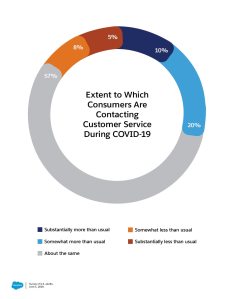Click here to explore data across demographics and geographies.
As stay-at-home orders expanded over the past three months and consumer demand plummeted, companies spanning all sectors of the economy have been challenged to engage shaken and confused customers with questions and demands that would be considered unreasonable during normal times. Salesforce surveyed over 3,500 consumers worldwide to understand what customers actually need during these unprecedented times, and how companies can delight them in the absence of a playbook. Here are some key takeaways from respondents in the United States.
Case volume is mostly stable as economic activity wanes
Despite widespread business shutdowns, customer service case volume is mostly stable or on an uptick as customers seek assistance and guidance under rapidly evolving circumstances.
57% of Americans are contacting customer service the same amount as they used to, and 30% are contacting customer service more than they used to. Only 13% of Americans say they’re contacting customer service less than before.
Millennials have ramped up their interactions with customer service the most. 46% of American millennials say they’re contacting customer service more than before, and just 10% say they’re contacting customer service less than before. This is in contrast to the 42% of Gen Xers and 11% of baby boomers who are contacting customer service more.

Digital channels take precedence as engagement moves online
Reflecting the ubiquity of Google in nearly every facet of our lives, customers are most likely to first turn to a third-party search engine when seeking information or service, rather than a company’s owned channel. The second stop on their journey for answers is a tool that’s been around a little longer: the phone.
While search engines and phone calls are in each generation’s top three sources of information, the similarities end there. After exhausting those options, baby boomers and Gen Xers are likely to head over to a physical store or office for an in-person visit — even in the midst of a pandemic. Millennials, on the other hand, are likely to turn to web chat features such as pop ups on a company’s website.
The rise of Gen Z, however, is pulling customer service channels into new territory. After search, these youngest customers are most likely to get the help and information they need over social media. Regardless of personal preferences, companies are especially challenged to service Gen Z on their terms; Gen Zers rank means of communication as the most important customer service quality, while no other generation puts it in their top three.

The stereotype of texting teens and twenty somethings is debunked when it comes to customer service preferences. Baby boomers are the most likely to seek support over text, whereas millenials and Gen Zers rank it as their least preferred channel.
Empathy and flexibility are prized amid uncertainty
With life feeling nothing close to usual, businesses aren’t operating as usual, either. Faced with unprecedented situations that they did not anticipate, consumers are looking for companies to recognize their extraordinary circumstances and act accordingly.
In fact, Americans now rate flexibility as the most important customer service quality, a fact that‘s reflected in corporate actions ranging from free ticket cancellations to rent discounts, extended loyalty status, and beyond.
The flexibility demonstrated by companies across sectors towards their customers reflects a business need, but also empathy with the confusion and uncertainty that’s now commonplace. Empathy ranks as the third most important customer service quality among Americans overall, but it’s the most important quality for low-income Americans that have been hit especially har by ongoing crises.

Companies may be sacrificing short-term revenue as they grant customers more leeway, but they’re hedging their bets for their long-term interests. 70% of Americans say companies that show care and empathy during the pandemic have earned their loyalty.
Consumers resist a move towards virtual field service
A 2019 study found huge investment in field service — such as technician appointments that take place at a customer’s location. Even amid a historic pandemic, those investments may have been well-founded.
67% of Americans say they would prefer an in-person appointment for appliance repair, cable TV service, or other types of field service, compared to 33% who would opt for a video appointment. Despite their relatively high vulnerability to COVID-19 infection, American baby boomers are the most likely group to opt for in-person appointments over video appointments (78% vs. 22%). Millennials are the most likely to prefer a video appointment, but the 39% of this generation that would go digital are still in the minority.
Industries receive mixed marks
Not all sectors of the economy are meeting customers’ high expectations for customer service during the pandemic. Retailers gain the highest marks from Americans, with 70% describing their service quality as “excellent” or “good.” By that measure, financial services and telecom companies round out the top three industries in terms of customer service quality.

On the other side of the spectrum, Americans rate the hard hit travel and hospitality sector as having provided the worst customer service recently. Yet government offices and programs are the most likely to receive a “poor” rating.
Methodology
Salesforce conducted a double-blind survey of adults in the United States, United Kingdom, France, Germany, Brazil, and Australia. Data was collected between May 14 and May 15, 2020 and yielded 3,569 responses. Data is weighted to accurately represent the general population.
















